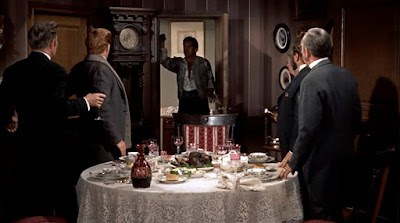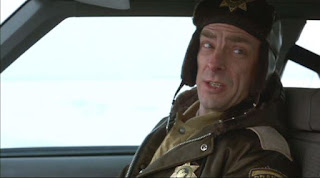It is speculated that time slows down, relatively, the closer you get to the speed of light (299,792,458 meters per second—it's just not a good idea; it's the law) or, more recently conceived, to a massive gravity source—say, a black hole. And there is speculation that by going faster than the speed of light, one could out-race time and catch up with it (as if it was a single-stream device, like a TIVO). Anyway, it worked (or will work) on "Star Trek."*
Either way, back, or forth, it seems it takes a lot of effort and energy for so little time.
It's all theory, though. Tick-tick-tick is the speed of things. At least for now.
And...now.
In George Pal's version of the H.G. Wells novel, the time is January 5th, 1900. H. George Wells (Rod Taylor) stumbles (just in time) into the pre-arranged meeting with his friends and acquaintances, David Filby (Alan Young), Dr. Philip Hillyer (Sebastian Cabot), Anthony Bridewell (Tom Helmore), and Walter Kemp (the ubiquitous Whit Bissell), and he looks bruised and bedraggled. He has a story to tell them about how he got that way—over his last few hours—and it has a lot to do with their meeting the week before—one that ended with much scoffing and condescension about George's crazy ideas.
At that meeting (as he reminds them), he posited the invention of a machine to cross "the fourth dimension"—time. He showed them a model, which—at the press of a switch—disappeared, and explaining to his gob-smacked and uncomprehending friends who wondered where it went that it was not a question of "where" it went but "when." The little model is still there, in that room, it's just in another time—where they are not. Philosophically, George is concerned that, with the Boer War going on and strife everywhere, that the answers to man's struggles must be in the future and he intends to see.
To a man, they are practical...and skeptical. His ideas and skills would be better put to helping the war effort, but George cannot be dissuaded. Fearing for his mind, Filby encourages George to see in the New Year with his family, but Wells refuses but assures his friend that he won't walk beyond his door that night. And, indeed, he won't. George decides to do that thing that all visionaries should be wary of—experimenting on oneself—and tests his full-size version of his time machine to travel, tentatively, into the future. He stops in 1917 and things have changed a bit—he monitors changes in fashion from a mannequin in a shop window across the street. Taking a tentative look outside, he runs into a person he thinks is Filby—but it's actually his son. Filby is dead and buried, and his son has just returned from The Great War. That doesn't auger well for Wells' dream of a better world, so he presses on.
A second trial takes him past WWII, where his time machine feels the effects of the blitz and he sees his rural town become surrounded by skyscrapers. Stopping in 1966, he's just "in time" to witness a nuclear bombardment that he only manages to escape with his machine. Volcanic activity leaves him sealed in a cave and he punches forward through time until erosion has taken its time and he can see daylight again. He stops at October 12, 802701. And the world has changed considerably.
Oh, there's oxygen, conveniently—the nuclear winter and volcanic activity seems to have subsided and formed a livable atmosphere after 802,000 years. The Earth that he encounters is verdant, lush, and judging from the life-forms appears to be in Malibu by way of Logan's Run.** Everybody is in their early 20's, are model-proportioned, and have sun-bleached blond hair (they're also extremely passive preferring to hang out by the river, and if someone falls in and is in danger of drowning, nobody helps—perhaps they're federal employees!)
But, these aren't the only bipeds roaming about in the 803rd century, merely the ones who see the light of day. Life has bifurcated to include another life-form that lives underground in a subterranean power-plant of tunnels and caves. These are the Morlocks, who prey—and feast—upon the youngsters (who should be called "Veal," but are, instead, called the "Eloi," who are beckoned to the underground chambers by a summons from a pyramid-like structure resembling a temple.
George is aghast at this, and by the Eloi's compliance; when a herd of Eloi is beckoned (including a comely Eloi he has become besotted with (played by Yvette Mimieux), he invades the Morlock Masonic and goes all "Spartacus" on them, inspiring a revolt against the Morlocks and saving the Eloi to return to a life of..."whatever" (that's exactly what they seem to be returning to...a life of "what-everrr") Despite his feelings for "Weena"—as he calls her—he decides to power up his time-machine and return to his present time...for a time, anyway.
It's a good little adaptation of the Wells book, full of fine antiquated period detail and adolescent thrills—if you're not thinking about it too much—which is a mark of the films of George Pal, ever-concerned with the whiz-bang image (effects are usually done in brisk stop-motion sequences) and, if there's a message, best to leave it immersed in sub-text or the basic DNA of the source. And Rod Taylor fit the bill for the type of just-charismatic-enough-for-the-budget star. Taylor hailed from Australia—adept enough that you'd never know it from the expert lack of accent (you could swear he was Canadian!), filtered down by years of stage, film and television work (this was his first starring role)—and makes a fine adventurer to identify with.
The film was remade in 2002 with Guy Pearce, and Nicholas Meyer made an excellent "cousin" film, Time After Time, in 1979. We'll be looking at the latter...some time.
Now, a final note about time-travel: don't dress lightly.
Oh, there's oxygen, conveniently—the nuclear winter and volcanic activity seems to have subsided and formed a livable atmosphere after 802,000 years. The Earth that he encounters is verdant, lush, and judging from the life-forms appears to be in Malibu by way of Logan's Run.** Everybody is in their early 20's, are model-proportioned, and have sun-bleached blond hair (they're also extremely passive preferring to hang out by the river, and if someone falls in and is in danger of drowning, nobody helps—perhaps they're federal employees!)
But, these aren't the only bipeds roaming about in the 803rd century, merely the ones who see the light of day. Life has bifurcated to include another life-form that lives underground in a subterranean power-plant of tunnels and caves. These are the Morlocks, who prey—and feast—upon the youngsters (who should be called "Veal," but are, instead, called the "Eloi," who are beckoned to the underground chambers by a summons from a pyramid-like structure resembling a temple.
George is aghast at this, and by the Eloi's compliance; when a herd of Eloi is beckoned (including a comely Eloi he has become besotted with (played by Yvette Mimieux), he invades the Morlock Masonic and goes all "Spartacus" on them, inspiring a revolt against the Morlocks and saving the Eloi to return to a life of..."whatever" (that's exactly what they seem to be returning to...a life of "what-everrr") Despite his feelings for "Weena"—as he calls her—he decides to power up his time-machine and return to his present time...for a time, anyway.
It's a good little adaptation of the Wells book, full of fine antiquated period detail and adolescent thrills—if you're not thinking about it too much—which is a mark of the films of George Pal, ever-concerned with the whiz-bang image (effects are usually done in brisk stop-motion sequences) and, if there's a message, best to leave it immersed in sub-text or the basic DNA of the source. And Rod Taylor fit the bill for the type of just-charismatic-enough-for-the-budget star. Taylor hailed from Australia—adept enough that you'd never know it from the expert lack of accent (you could swear he was Canadian!), filtered down by years of stage, film and television work (this was his first starring role)—and makes a fine adventurer to identify with.
The film was remade in 2002 with Guy Pearce, and Nicholas Meyer made an excellent "cousin" film, Time After Time, in 1979. We'll be looking at the latter...some time.
Now, a final note about time-travel: don't dress lightly.
The trouble with the depictions that we've seen is that they're a bit myopic—at least according to professional physics buzz-kill Dr. Neil Degrass Tyson. All time machines we've seen have been neatly rooted to the ground (at least, The Time Machine acknowledged that the very surroundings that it existed on would change over time). But, even as we're moving through time, so is the Earth. So is the Universe.
But let's simplify it. In the same way that a plane has to aim for the spot its destination will be at the time of arrival, you also have to do on a more cosmic scale. The Earth travels in its orbit around the sun at 29.78 km/s. So, that means if we wanted to travel, let's say, a day in the future, we should take a rocket to the point where the Earth would be in 24 hours, which would be 1,598,784 miles down the ecliptic. Say we did travel 24 hours in time; without compensating for the constant movement of the Universe, we would end our time-journey with the Earth "'way over there", and we'd be gasping for air before our lungs would explode...because we'd be in space.
But let's simplify it. In the same way that a plane has to aim for the spot its destination will be at the time of arrival, you also have to do on a more cosmic scale. The Earth travels in its orbit around the sun at 29.78 km/s. So, that means if we wanted to travel, let's say, a day in the future, we should take a rocket to the point where the Earth would be in 24 hours, which would be 1,598,784 miles down the ecliptic. Say we did travel 24 hours in time; without compensating for the constant movement of the Universe, we would end our time-journey with the Earth "'way over there", and we'd be gasping for air before our lungs would explode...because we'd be in space.
Always wear a space-suit when time travelling, kids (and take PLENTY of oxygen) because you may know WHEN you'll show up, but you might not know WHERE.
 |
| "Missed it by that much..." |
* Michael Crichton's "Timeline" proposed a simpler, more catastrophic solution to time-travel; it can't exist. "Time" doesn't flow as is the conception of pre-quantum time-travel stories—"Time doesn't pass; we pass" says a tech in it—and that what has been more romantically termed "time travel" is actually space-travel to another dimension in the multi-verse that has branched off. One could "travel" to those alternative branches by atomizing the human body and, upon reaching that dimension, reconstructing the physical form from its genetic map. Sounds really, really complicated, but, again, it worked "so well" on "Star Trek."
 |
| Transporter accident as imagined by the late, great Mort Drucker |
* I didn't know this until I was doing some research on Pal, but he was trying to get a "Logan's Run" adaptation as early as 1968.

















































